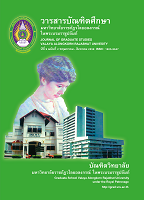การพัฒนารูปแบบการจัดกิจกรรมต้านยาเสพติดในกลุ่มนักเรียน
Main Article Content
Abstract
การวิจัยนี้มีวัตถุประสงค์ เพื่อศึกษาวิเคราะห์ปัจจัยเชิงสาเหตุของปัญหายาเสพติดในกลุ่มนักเรียนและเพื่อพัฒนารูปแบบกิจกรรมต้านยาเสพติดในกลุ่มนักเรียน เก็บข้อมูลด้วยแบบสอบถามจากนักเรียนชั้นมัธยมศึกษาปีที่ 1 ประจำปีการศึกษา 2555 จำนวน 357 คน และวิเคราะห์โมเดลเชิงสาเหตุให้สอดคล้องกับข้อมูลเชิงประจักษ์ ด้วยเทคนิคการวิเคราะห์โครงสร้างเชิงเส้น ผลการวิจัย พบว่า องค์ประกอบด้านปัจจัยเชิงสาเหตุการติดยาเสพติดในกลุ่มนักเรียน ประกอบด้วย 1.1 ปัจจัยด้านสติปัญญา (Intelligence Quotient) 1.2 ปัจจัยด้านความฉลาดทางอารมณ์ (Emotional Quotient) 1.3 ปัจจัยด้านความสามารถในการแก้ปัญหาและการกล้าเผชิญวิกฤต (Adversity Quotient) 1.4 ปัจจัยด้านครอบครัว (Family) 1.5 ปัจจัยด้านสังคมและสิ่งแวดล้อม (Social and Environment) 1.6 ปัจจัยด้านโรงเรียน (School) และ 1.7 ปัจจัยด้านพฤติกรรมการติดยาเสพติดในกลุ่มนักเรียน (Behavior) โมเดลมีความสอดคล้องกับข้อมูลเชิงประจักษ์ค่าน้ำหนักองค์ประกอบอยู่ระหว่าง 0.11 - 4.32 ประกอบด้วย ด้านสติปัญญา โมเดลมีความสอดคล้องกับข้อมูลเชิงประจักษ์มีค่าน้ำหนักองค์ประกอบอยู่ระหว่าง 0.89 ถึง 2.83 ด้านความฉลาดทางอารมณ์ โมเดลมีความสอดคล้องกับข้อมูลเชิงประจักษ์มีค่าน้ำหนักองค์ประกอบระหว่าง 1.89 ถึง 2.42 ด้านความสามารถในการแก้ปัญหาและการกล้าเผชิญวิกฤต โมเดลมีความสอดคล้องกับข้อมูลเชิงประจักษ์มีค่าน้ำหนักองค์ประกอบอยู่ระหว่าง 1.96 ถึง 2.60 ด้านครบครัว โมเดลมีความสอดคล้องกับข้อมูลเชิงประจักษ์มีค่าน้ำหนักองค์ประกอบอยู่ระหว่าง 1.82 ถึง 2.50 ด้านสังคมและสิ่งแวดล้อม โมเดลมีความสอดคล้องกับข้อมูลเชิงประจักษ์มีค่าน้ำหนักองค์ประกอบอยู่ระหว่าง 2.04 ถึง 2.74 ด้านโรงเรียน โมเดลมีความสอดคล้องกับข้อมูลเชิงประจักษ์มีค่าน้ำหนักองค์ประกอบอยู่ระหว่าง 0.92 ถึง 2.29 และด้านพฤติกรรมการติดยาเสพติดในกลุ่มนักเรียน โมเดลมีความสอดคล้องกับข้อมูลเชิงประจักษ์มีค่าน้ำหนักองค์ประกอบอยู่ระหว่าง 0.48 ถึง 1.43 และปัจจัยเชิงสาเหตุที่มีต่อพฤติกรรมการติดยาเสพติดในกลุ่มนักเรียน พบว่า โมเดลมีความสอดคล้องกับข้อมูลเชิงประจักษ์ ซึ่งพิจารณาได้จากค่าไค-สแควร์ มีค่าเท่ากับ 328.29; p=0.37763 ที่องศาอิสระเท่ากับ 321 และดัชนีวัดระดับความกลมกลืน (GFI) เท่ากับ 0.94 ดัชนีวัดระดับความกลมกลืนที่ปรับแก้แล้ว (AGFI) เท่ากับ 0.92 ดัชนีวัดระดับความสอดคล้องเปรียบ เทียบ (CFI) เท่ากับ 1.00 ค่าดัชนีรากกำลังสองเฉลี่ยของความคลาดเคลื่อนในการประมาณค่า (RMSEA) มีค่าเท่ากับ 0.008 ค่าสัมประสิทธิ์การพยากรณ์ตัวแปรตาม คือ พฤติกรรมการติดยาเสพติดของนักเรียน มีค่าเท่ากับ 0.94 แสดงว่า ตัวแปรในโมเดลสามารถอธิบาย ความแปรปรวนของตัวแปรพฤติกรรมการติดยาเสพติดของนักเรียน ได้ร้อยละ 94
The objectives of this research was to study the drug behavior of matthayomsuksa students and factors affecting the drug behavior of matthayomsuksa students; 357 sample of matthayomsuksa students 1 academic year 2012 with questionnaire. Analysis was made on causal relationship model and its to the empirical data, using the Linear Structural Relationship technique. The research findings were as follows: The components of the drug behavior of matthayomsuksa students comprise 1.1) Intelligence Quotient, 1.2) Emotional Quotient, 1.3) Adversity Quotient, 1.4) Family, 1.5) Social and Environment, 1.6) School and 1.7) Drug behavior. The model demonstrated good fit to the empirical data, with factor leadings ranged between 0.48 and 2.83. Factors affecting the Drug behavior of matthayomsuksa students are Intelligence Quotient, with good fit to the empirical data, facto loadings ranged between 0.89 and 2.83; Emotional Quotient, with good fit to the empirical data, factor loadings ranged between 1.89 and 2.42; Adversity Quotient, with good fit to the empirical data, factor loadings ranged between 1.96 and 2.60; Family, with good fit to the empirical data, factor loadings ranged between 1.82 and 2.50; Social and Environment, with good fit to the empirical data, loading factors ranged between 2.04 and 2.74. School, with good fit to the empirical data, loading factors ranged between 0.92 and 2.29 and Drug behavior, with good fit to the empirical data, loading factors ranged between 0.48 and 1.43 and The Drug behavior of students, the model demonstrated good fit to the empirical data, with factor leadings ranged between 0.48 and 2.83. The Factors affecting of Drug behavior of students and the model demonstrated good fit data with Chi-square=328.29, df =321, P-value=0.37763, GFI=0.94, AGFI=0.92, CFI=1.00 RMSEA=0.008 and R-SQUARE of predicted the Drug behavior of Matthayomsuksa students is 0.94, the result avaliable to describe the varible in the model, the variable error of Drug behavior of students is equal to 94 percents.
Article Details

This work is licensed under a Creative Commons Attribution-NonCommercial-NoDerivatives 4.0 International License.
บทความทุกเรื่องได้รับการตรวจความถูกต้องทางวิชาการโดยผู้ทรงคุณวุฒิ ทรรศนะและข้อคิดเห็นในบทความ Journal of Global of Perspectives in Humanities and Social Sciences (J-GPHSS) มิใช่เป็นทรรศนะและความคิดของผู้จัดทำจึงมิใช่ความรับผิดชอบของบัณฑิตวิทยาลัย มหาวิทยาลัยราชภัฏวไลยอลงกรณ์ ในพระบรมราชูปถัมภ์ กองบรรณาธิการไม่สงวนสิทธิ์การคัดลอก แต่ให้อ้างอิงแหล่งที่มา


